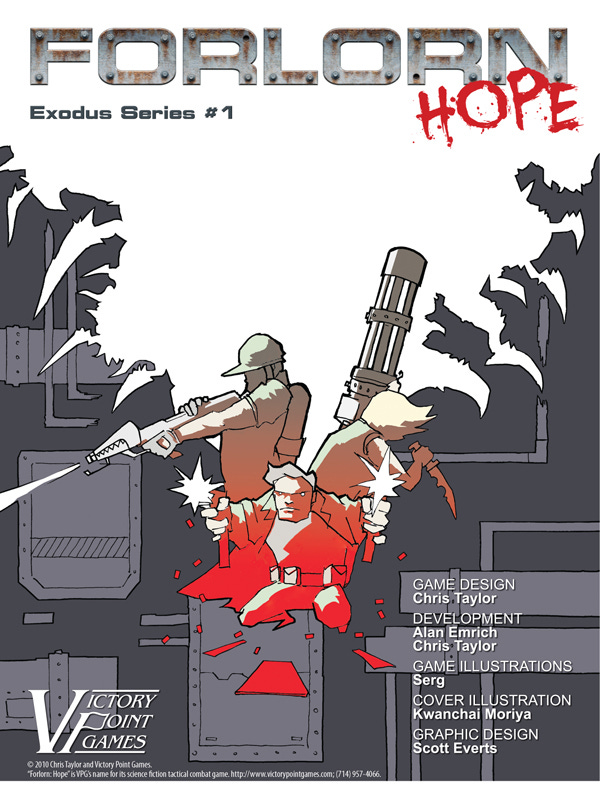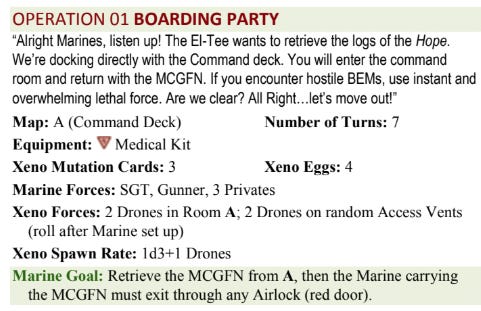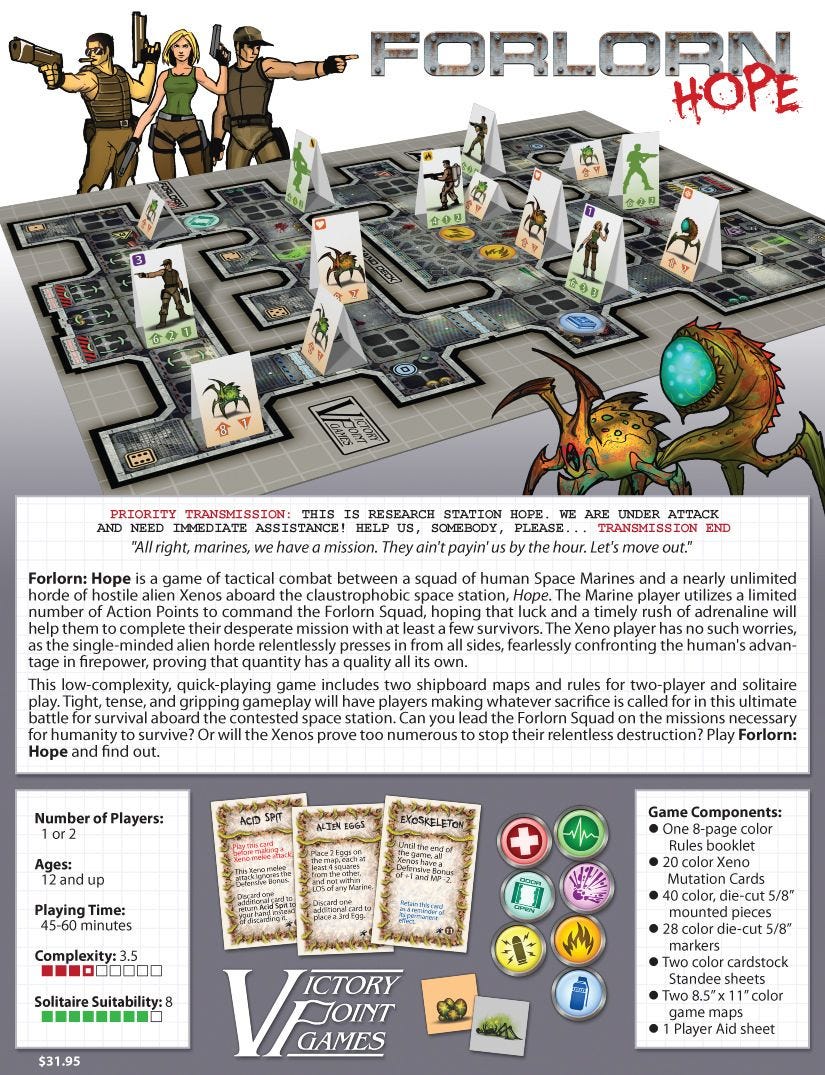Table Top Retro-Review: Forlorn Hope
A Fantastic Desk Top Published Science Fiction Game
A couple of weeks ago, I wrote a brief obituary for Alan Emrich and discussed how much a brief visit to the old Victory Point Games office meant to me as a gamer. During that visit, I play tested the then upcoming title Assault on Galactus Prime with the game's designer and had a wonderful time. I was also able to meet one of my favorite game designers -- in both computer and print games -- Chris Taylor. When it comes to game mechanics and concepts, it just seems that Chris Taylor has a direct link into my subconscious. Either that or we have been having secret psychic discussions about games, books, movies, etc. for decades.
A perfect example of how his designs seem custom made for me is his design on the Forlorn: Hope board game.
Forlorn: Hope has a familiar and well loved theme, Marines vs. Aliens. Ever since I first read Heinlein's Starship Troopers, I have been a fan of the genre. I own a number of games that follow the theme: Bughunters, Starship Troopers, Space Hulk, Death Angel, Aliens, Doom of the Eldar, to name only a few. Basically, if it has a small squad of outnumbered and desperate combatants facing off against a rapidly populating army of insect-like foes, I'm game.
Bringing the Game to the Table
When Forlorn: Hope was initially released, I was jonesing for a new addition to the genre. In actuality, I was jonesing for a game of Space Hulk 1st edition, but was having trouble finding one at an affordable price on eBay. I owned the 2nd edition, but I wanted to play with the original "d6" based rules. During one of my searches, browsed some of my regular website haunts and read one of Victory Point Games bi-weekly reports. I immediately noticed that they were featuring a new game by Chris Taylor called Forlorn: Hope. As I was already a fan of his, and of VPG, I immediately ordered a copy. Not long after this, Games Workshop released a limited edition of Space Hulk 3rd edition which used the mechanics of the 1st edition, so that itch was also scratched. I carried my copy of Forlorn: Hope around for months, but it took a while for the stars to align to put together a play session.
That opportunity came when I experienced the dilemma that all Gamemasters face when running role playing games and a majority of my gaming group had last minute obligations that prevented them from coming over. I should have known this would happen because our regularly scheduled game day fell upon a holiday weekend. It turned out that only one of my regular gaming group, Eric Lytle, was able to stop by. Thankfully, Eric was one of the few members of my regular group who loves board games as much as I do and he's a fan of the Marines vs. Aliens genre to boot. I pulled out my copy of Forlorn: Hope, went over the rules with Eric, and played two quick scenarios. All of which took slightly more than two hours. The rules were clear, the play was quick, and the game exciting.
The Rules
The rules to Forlorn: Hope are simple enough for the beginning gamer, but dynamic enough to satisfy the veteran.
One player takes the role of the space Marines who venture aboard a savaged space station named Hope. The Marine player is given a mission objective that must be fulfilled. The other player controls the Xeno "Mind" and seeks to devour all of the delicious Marines foolish enough to venture onto the Hope.
The missions define the make up of the Marine squad and the forces available to the Xeno "Mind." The players set up according to the basic rules, and the Xeno player draws a number of "mutation" cards which can affect game play as the mission unfolds. This is a wonderful element that adds variety to this game and makes it more than a Space Hulk clone.
For example, in the “Boarding Party” mission the Marine player us charged with locating and retrieving the “Master Control General Function Neuralnet” (MCGFN aka MacGuffin) and bringing it back to the Airlock. The mission allows the Marine player to have a Sergeant, a Gunner, and 3 Privates and let’s just say that while the Xeno Forces in this first mission are “easy mode” that the mission is far from easy to succeed with.
At the beginning of each turn the Marine player rolls to determine how many Action Points he or she has to spend on actions, every movement or shot that the player wants a Marine to do requires the expenditure of points. Where the Marine player has a limited number of Action Points, the Xeno player gets to activate every living Xeno during his or her turn.
Play goes quickly and the combat resolution system is quick and deadly. When a character attacks another character, that player rolls a number of six sided dice equal the unit’s printed Attack Value. The results are compared to the target unit’s Defense Value and any die result that is greater than the target’s Defense Value is a hit. It’s a very simple core system to which some factors like range are added for tactical depth of play. The temptation is to play cautiously as the Marine player, but each scenario has a limited number of turns for the player to fulfill the objective and play must be fairly aggressive to succeed, seven in the case of the first mission.
The first two sessions I played were bloodbaths, but the Marines did manage to recover the "Master Control General Function Neuralnet" from the Hope in both instances. Forlorn: Hope manages to capture the hopelessness, desperation, and horror of the best sessions of Space Hulk while keeping game play simple enough that the action never bogs down into rules discussions.
Because Victory Point Games products were print to order, essentially high end desk top publishing games, the games were fairly expensive when they were released. Forlorn Hope cost around $35 at the time of release, but the very limited print runs mean that they go for about $70 now. I really wish there were more companies working on the old Victory Point Games model. Their games were crafted by hand by a company dedicated to making every gamer into a game designer. They were truly a community game company where they were open to people bringing in their designs to have them playtested and eventually added to the game catalog.
VPG is the only game company that I can think of that was built on the premise that it was both a company and a classroom. When I finish my dissertation, and after finances get a little more stable, I might just look into starting up a Boise area company based on this model. Making PDFs is very cheap to do and getting the right printer and once you have die cast for cutting tokens they can be used for a wide variety of pieces. We’ll see about that though.
One thing is for sure, given how quickly a session of Forlorn: Hope goes by, and considering the replay value due to different scenarios and mutation card effects, there was a lot of bang for your gaming buck in this product. Hunt down a copy if you can. Maybe, just maybe, I’ll make a fantasy alternative to the game and post the files here. After all, you can copyright specific text, but game mechanics themselves are open to the public. This is especially true when the mechanics are pretty much, “roll against a target number” a mechanic that has its roots in Craps.






LOL! Only after reading your article did I realize that "MCGFN" was meant to be "MacGuffin".